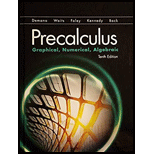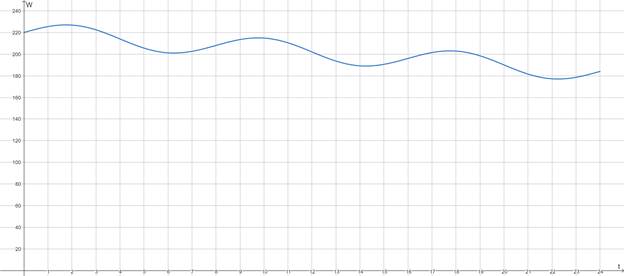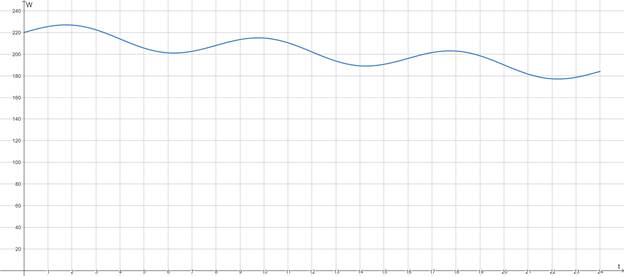
a.
Courtney’s weight at the start and at the end of two years.
Courtney’s weight at the start and at the end of two years is 220 and 184 pounds respectively.
Given:
Given, Courtney tried several different diets over a two-year period in an attempt to lose weight. She found that her weight W followed a fluctuating curve that could be modeled by the function
Calculation:
At the start of the two years, t is 0. And at the end of two years i.e., 24 months, t is 24.
Plugging the values:
Courtney’s weight at the start and at the end of two years is 220 and 184 pounds respectively.
Conclusion:
Courtney’s weight at the start and at the end of two years is 220 and 184 pounds respectively.
b.
Courtney’s maximum weight during the two-year period.
Courtney’s maximum weight during the two-year period is 227 pounds.
Given:
Given, Courtney tried several different diets over a two-year period in an attempt to lose weight. She found that her weight W followed a fluctuating curve that could be modeled by the function
Calculation:
Graphing the function for t between 0 and 24:

From the graph, it is seen that the maximum weight during the two-year period is approximately 227 pounds.
Conclusion:
Courtney’s maximum weight during the two-year period is 227 pounds.
c.
Courtney’s minimum weight during the two-year period.
Courtney’s minimum weight during the two-year period is 177 pounds.
Given:
Given, Courtney tried several different diets over a two-year period in an attempt to lose weight. She found that her weight W followed a fluctuating curve that could be modeled by the function
Calculation:
Graphing the function for t between 0 and 24:

From the graph, it is seen that the minimum weight during the two-year period is approximately 177 pounds.
Conclusion:
Courtney’s minimum weight during the two-year period is 177 pounds.
Chapter 4 Solutions
EBK PRECALCULUS:GRAPHICAL,...-NASTA ED.
- Use a graphing calculator to find where the curves intersect and to find the area between the curves. y=ex, y=-x²-4x a. The left point of intersection is (Type integers or decimals rounded to the nearest thousandth as needed. Type an ordered pair.)arrow_forwardFind the area between the curves. x= -5, x=3, y=2x² +9, y=0 The area between the curves is (Round to the nearest whole number as needed.)arrow_forwardcan you solve these questions with step by step with clear explaination pleasearrow_forward
- Find the area between the following curves. x=-1, x=3, y=x-1, and y=0 The area between the curves is (Simplify your answer.)arrow_forwardFind the area between the curves. x= − 2, x= 3, y=5x, y=x? - 6 6 The area between the curves is (Simplify your answer.) ...arrow_forwardplease question 9arrow_forward
- Use the definite integral to find the area between the x-axis and f(x) over the indicated interval. Check first to see if the graph crosses the x-axis in the given interval. 3. f(x) = 4x; [-5,3]arrow_forwardUse the definite integral to find the area between the x-axis and f(x) over the indicated interval. Check first to see if the graph crosses the x-axis in the given interval. f(x)=3e-4; [3,3]arrow_forwardA small company of science writers found that its rate of profit (in thousands of dollars) after t years of operation is given by P'(t) = (7t + 14) (t² + 4t+7) * (a) Find the total profit in the first four years. (b) Find the profit in the sixth year of operation. (c) What is happening to the annual profit over the long run?arrow_forward
- Calculus III May I have an expert explained how the terms were simplified into 6(3-x)^2? Thank you,arrow_forwardCalculus III May I have an expert explain how the integrand was simplified into the final for form to be integrated with respect to x? Thank you,arrow_forwardCalculus lll May I please have the semicolon statement in the box defined with explanation? Thank you,arrow_forward
 Calculus: Early TranscendentalsCalculusISBN:9781285741550Author:James StewartPublisher:Cengage Learning
Calculus: Early TranscendentalsCalculusISBN:9781285741550Author:James StewartPublisher:Cengage Learning Thomas' Calculus (14th Edition)CalculusISBN:9780134438986Author:Joel R. Hass, Christopher E. Heil, Maurice D. WeirPublisher:PEARSON
Thomas' Calculus (14th Edition)CalculusISBN:9780134438986Author:Joel R. Hass, Christopher E. Heil, Maurice D. WeirPublisher:PEARSON Calculus: Early Transcendentals (3rd Edition)CalculusISBN:9780134763644Author:William L. Briggs, Lyle Cochran, Bernard Gillett, Eric SchulzPublisher:PEARSON
Calculus: Early Transcendentals (3rd Edition)CalculusISBN:9780134763644Author:William L. Briggs, Lyle Cochran, Bernard Gillett, Eric SchulzPublisher:PEARSON Calculus: Early TranscendentalsCalculusISBN:9781319050740Author:Jon Rogawski, Colin Adams, Robert FranzosaPublisher:W. H. Freeman
Calculus: Early TranscendentalsCalculusISBN:9781319050740Author:Jon Rogawski, Colin Adams, Robert FranzosaPublisher:W. H. Freeman
 Calculus: Early Transcendental FunctionsCalculusISBN:9781337552516Author:Ron Larson, Bruce H. EdwardsPublisher:Cengage Learning
Calculus: Early Transcendental FunctionsCalculusISBN:9781337552516Author:Ron Larson, Bruce H. EdwardsPublisher:Cengage Learning





